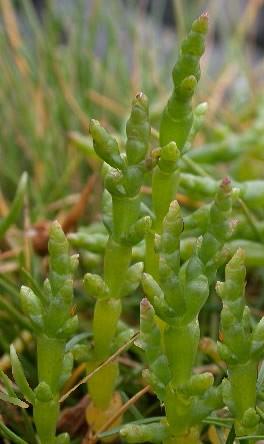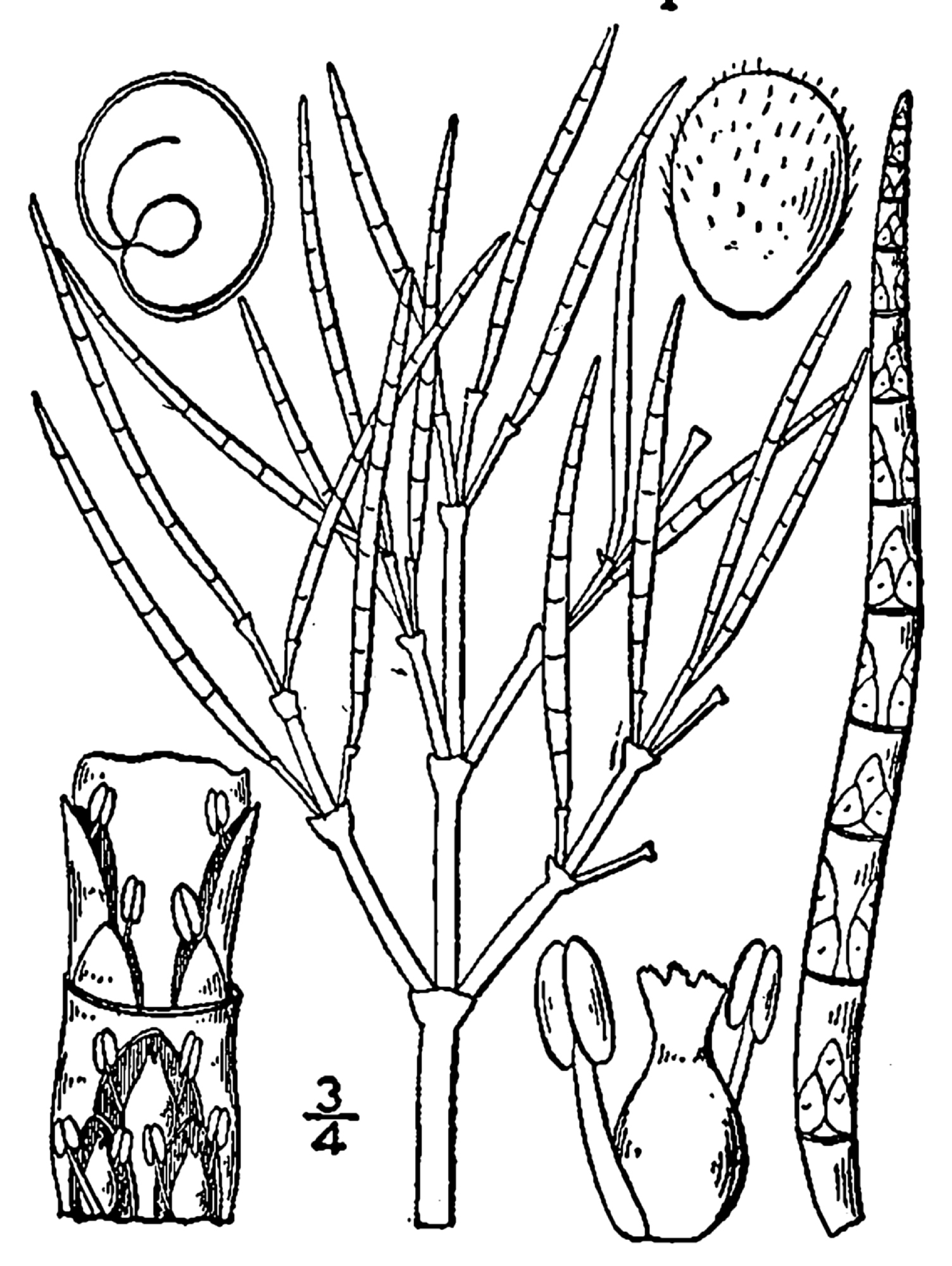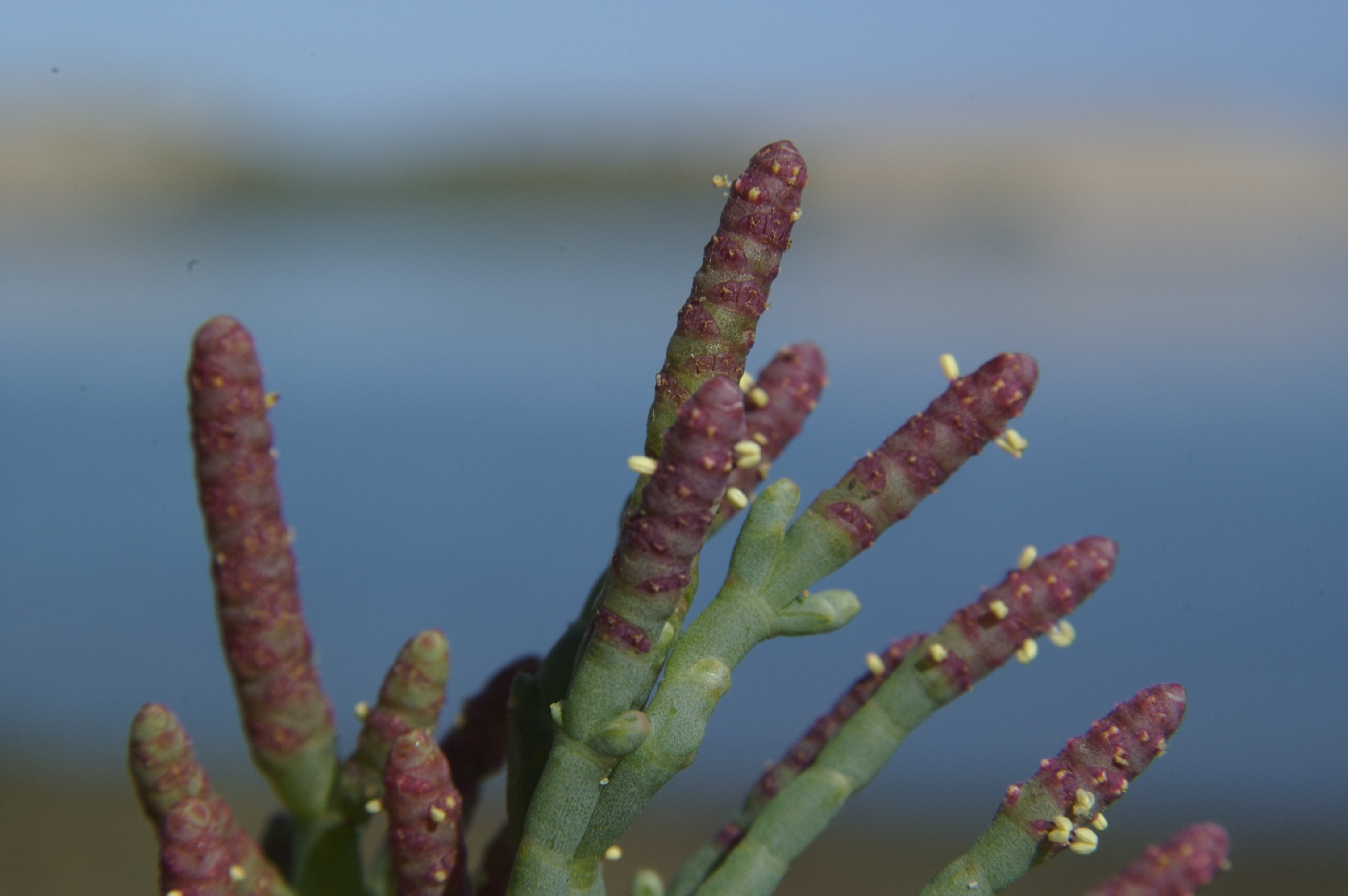|
Samphire
Samphire is a name given to a number of succulent salt-tolerant plants (halophytes) that tend to be associated with water bodies. * Rock samphire ('' Crithmum maritimum'') is a coastal species with white flowers that grows in Ireland, the United Kingdom and the Isle of Man. This is probably the species mentioned by Shakespeare in ''King Lear''. * Golden samphire (''Limbarda crithmoides'') is a coastal species with yellow flowers that grows across Eurasia. * Several species in the genus ''Salicornia'', known as "marsh samphire" in Britain. * '' Blutaparon vermiculare'', Central America, southeastern North America * '' Tecticornia'', Australia * '' Sarcocornia'', cosmopolitan Following the construction of the Channel Tunnel, the nature reserve created on new land near Folkestone made from excavated rock was named " Samphire Hoe", a name coined by Mrs Gillian Janaway. Etymology Originally "sampiere", a corruption of the French "Saint Pierre" (Saint Peter), samphire was named af ... [...More Info...] [...Related Items...] OR: [Wikipedia] [Google] [Baidu] |
Crithmum
''Crithmum'' is a monospecific genus of flowering plant in the carrot family, Apiaceae. The sole species, ''Crithmum maritimum'', is commonly known as rock samphire, sea fennel or samphire. It is found in parts of the Old World and is edible. Description It is a perennial plant growing to in both height and width. The Plant stem, stems are woody at the base, fleshy elsewhere and hairless. The leaves are fleshy lobes. The greenish-yellow flowers are borne in umbels. The fruits (seed pods) are yellow or purple and up to . Distribution and habitat Crithmum is found on coastlines throughout much of Europe (north to the British Isles), Macaronesia, parts of West Asia and North Africa in the Atlantic, Mediterranean and Black Sea coasts. Cultivation In Britain, rock samphire is cultivated in gardens, where it grows readily in a light, rich soil. In the United Kingdom the uprooting of wild plants is illegal under the Wildlife and Countryside Act. Uses Rock samphire or sea fenne ... [...More Info...] [...Related Items...] OR: [Wikipedia] [Google] [Baidu] |
Salicornia
''Salicornia'' is a genus of succulent, halophytic (salt tolerant) flowering plants in the family Amaranthaceae that grow in salt marshes, on beaches, and among mangroves. ''Salicornia'' species are native to North America, Europe, central Asia, and southern Africa. Common names for the genus include glasswort, pickleweed, picklegrass, and marsh samphire; these common names are also used for some species not in ''Salicornia''. To French speakers in Atlantic Canada, they are known colloquially as ('mouse tits'). The main European species is often eaten, called marsh samphire in Britain, and the main North American species is occasionally sold in grocery stores or appears on restaurant menus as sea beans, samphire greens or sea asparagus. Description The ''Salicornia'' species are small annual herbs. They grow prostrate to erect, their simple or branched stems are succulent, hairless, and appear to be jointed. The opposite leaves are strongly reduced to small fleshy scales with ... [...More Info...] [...Related Items...] OR: [Wikipedia] [Google] [Baidu] |
Samphire Hoe Country Park
Samphire Hoe is a country park situated west of Dover in Kent in southeast England. The park was created by using 4.9 million cubic metres of chalk marl from the Channel Tunnel excavations and is found at the bottom of a section of the White Cliffs of Dover. The site is owned by Getlink, and managed by the White Cliffs Countryside Project. It is accessible by the public via a single-lane road tunnel controlled by traffic lights, which crosses over the South Eastern Main Line that is running in the Shakespeare Cliff tunnel underneath. Visitor facilities are provided, including car parking, toilets and a café. Origin of the name Samphire Hoe is named after the wild plant rock samphire that was once collected from the Dover cliffs; its fleshy green leaves were picked in May and pickled in barrels of brine and sent to London, where it was served as a dish to accompany meat. A 'hoe' is a piece of land which sticks out into the sea. The name was coined by Mrs Gillian Jana ... [...More Info...] [...Related Items...] OR: [Wikipedia] [Google] [Baidu] |
Tecticornia
''Tecticornia'' is a genus of succulent, salt tolerant plants largely endemic to Australia. Taxa in the genus are commonly referred to as samphires. In 2007, the genus ''Halosarcia'', along with three other Australian genera (''Pachycornia'', ''Sclerostegia'' and ''Tegicornia'') was incorporated into the genus. Description The species of ''Tecticornia'' grow as annual or perennial herbs, subshrubs or small shrubs. Stems are branched, glabrous and appear jointed. The opposite leaves are fleshy, glabrous, connate in the lower part and cup-like or collar-like stem-clasping, with minute (0–3 mm long) two-lobed to triangular leaf blades. The spike-shaped inflorescences consist of opposite bracts, mostly connate and stem-clasping, free in some species. Their blades are cup- or collar-like or deltoid to semi-circular scales. In the axil of each bract, there are three to five (rarely one or seven) flowers, free or sometimes fused to each other, to the bract, and to the in ... [...More Info...] [...Related Items...] OR: [Wikipedia] [Google] [Baidu] |
Golden Samphire
The golden samphire (''Limbarda crithmoides'') is a perennial coastal species, which may be found growing on salt marsh or sea cliffs across western and southern Europe and the Mediterranean. Golden samphire has a tufted habit, and the plant may grow up to 1 m tall. It has narrow fleshy green to yellow green leaves and large flower heads, with six yellow ray florets which may be up to across. The flowers are self-fertile (able to pollinate themselves) and may also be pollinated by bees, flies and beetles. They bloom between June and October and can smell like shoe polish.Chris Gibson Taxonomy It was first described by Carl Linnaeus as ''Inula crithmoides'' in his book ''Species Plantarum'' 2 on page 883 in 1753 and then later when the genus was renamed, it was published as ''Limbarda crithmoides'' by Barthélemy Charles Joseph Dumortier in Fl. Belg. on page 68 in 1827. It was verified by United States Department of Agriculture and the Agricultural Research Service on 11 June ... [...More Info...] [...Related Items...] OR: [Wikipedia] [Google] [Baidu] |
Glasswort
The glassworts are various succulent, annual halophytic plants, that is, plants that thrive in saline environments, such as seacoasts and salt marshes. The original English glasswort plants belong to the genus '' Salicornia'', but today the glassworts include halophyte plants from several genera, some of which are native to continents unknown to the medieval English, and growing in ecosystems, such as mangrove swamps, never envisioned when the term glasswort was coined. The common name "glasswort" came into use in the 16th century to describe plants growing in England whose ashes could be used for making soda-based (as opposed to potash-based) glass.Turner, William (1995). ''A New Herball: Parts II and III'', edited by George T. L. Chapman, Frank McCombie, and Anne U. Wesencraft (Cambridge University Press, ). This book contains a facsimile of Turner's original 1562 and 1568 volumes, along with an edited transcript. The transcript of Turner's article on Kali (p. 673) includes t ... [...More Info...] [...Related Items...] OR: [Wikipedia] [Google] [Baidu] |
Blutaparon Vermiculare
''Gomphrena vermicularis'', with common names silverhead, silverweed, saltweed, and samphire, is a species of plant in the family Amaranthaceae, native to the Americas from the southeastern United States to Mexico, Central America Central America is a subregion of North America. Its political boundaries are defined as bordering Mexico to the north, Colombia to the southeast, the Caribbean to the east, and the Pacific Ocean to the southwest. Central America is usually ..., the Caribbean, northern South America, and Brazil, and to western and central tropical Africa from Mauritania to Angola. It has edible stems and leaves. References vermicularis Flora of Texas Flora of Louisiana Flora of Florida Flora of Mexico Flora of the Caribbean Flora of Central America Flora of northern South America Flora of Brazil Flora of Colombia Flora of Ecuador Flora of West Tropical Africa Flora of West-Central Tropical Africa Flora of Angola Plants described in 1753 Taxa ... [...More Info...] [...Related Items...] OR: [Wikipedia] [Google] [Baidu] |
Sarcocornia
''Sarcocornia'' is a formerly recognized genus of flowering plants in the amaranth family, Amaranthaceae. Species are known commonly as samphires, glassworts, or saltworts. Molecular phylogenetic studies have shown that when separated from ''Salicornia'', the genus is paraphyletic, since ''Salicornia'' is embedded within it, and ''Sarcocornia'' has now been merged into a more broadly circumscribed ''Salicornia''. When separated from ''Salicornia'', the genus has a cosmopolitan distribution, and is most diverse in the Cape Floristic Region of South Africa. Description Species formerly placed in ''Sarcocornia'' are perennial herbs, subshrubs or shrubs. They are taking an erect or prostrate, creeping form. The new stems are fleshy and divided into joint-like segments. Older stems are woody and not segmented. The oppositely arranged leaves are borne on fleshy, knobby petioles, their base decurrent and connate (thus forming the segments), the blades forming small, triangular tips wit ... [...More Info...] [...Related Items...] OR: [Wikipedia] [Google] [Baidu] |
Biodiesel
Biodiesel is a renewable biofuel, a form of diesel fuel, derived from biological sources like vegetable oils, animal fats, or recycled greases, and consisting of long-chain fatty acid esters. It is typically made from fats. The roots of biodiesel as a fuel source can be traced back to when J. Patrick and E. Duffy first conducted transesterification of vegetable oil in 1853, predating Rudolf Diesel's development of the diesel engine. Diesel's engine, initially designed for mineral oil, successfully ran on peanut oil at the 1900 Paris Exposition. This landmark event highlighted the potential of vegetable oils as an alternative fuel source. The interest in using vegetable oils as fuels resurfaced periodically, particularly during resource-constrained periods such as World War II. However, challenges such as high viscosity and resultant engine deposits were significant hurdles. The modern form of biodiesel emerged in the 1930s, when a method was found for transforming vegetable ... [...More Info...] [...Related Items...] OR: [Wikipedia] [Google] [Baidu] |
Saudi Aramco
Saudi Aramco ( ') or Aramco (formerly Arabian-American Oil Company), officially the Saudi Arabian Oil Company, is a majority state-owned petroleum and natural gas company that is the national oil company of Saudi Arabia. , it is the fourth- largest company in the world by revenue and is headquartered in Dhahran. Saudi Aramco has both the world's second-largest proven crude oil reserves, at more than , and largest daily oil production of all oil-producing companies. Saudi Aramco operates the world's largest single hydrocarbon network, the Master Gas System. In 2024, its oil production total was 12.7 million barrels of oil equivalent per day, and it manages over one hundred oil and gas fields in Saudi Arabia, including 288.4 trillion standard cubic feet (scf) of natural gas reserves. Along the Eastern Province, Saudi Aramco most notably operates the Ghawar Field (the world's largest onshore oil field) and the Safaniya Field (the world's largest offshore oil field). [...More Info...] [...Related Items...] OR: [Wikipedia] [Google] [Baidu] |
Norfolk Samphire
Norfolk ( ) is a ceremonial county in England, located in East Anglia and officially part of the East of England region. It borders Lincolnshire and The Wash to the north-west, the North Sea to the north and east, Cambridgeshire to the west, and Suffolk to the south. The largest settlement is the city of Norwich. The county has an area of and a population of 859,400. It is largely rural with few large towns: after Norwich (147,895), the largest settlements are King's Lynn (42,800) in the north-west, Great Yarmouth (38,693) in the east, and Thetford (24,340) in the south. For local government purposes Norfolk is a non-metropolitan county with seven districts. The centre of Norfolk is gently undulating lowland. To the east are the Broads, a network of rivers and lakes which extend into Suffolk and which are protected by the Broads Authority, which give them a similar status to a national park. To the west the county contains part of the Fens, an extremely flat former marsh, and ... [...More Info...] [...Related Items...] OR: [Wikipedia] [Google] [Baidu] |





